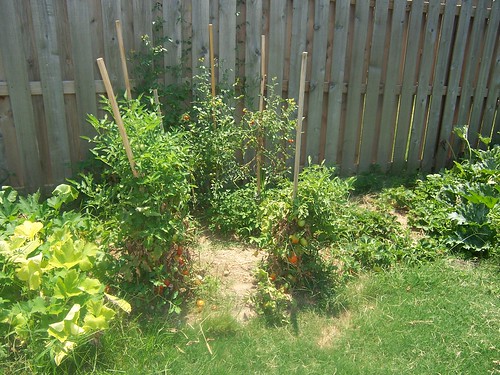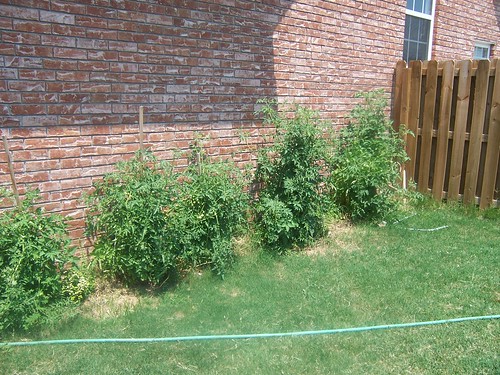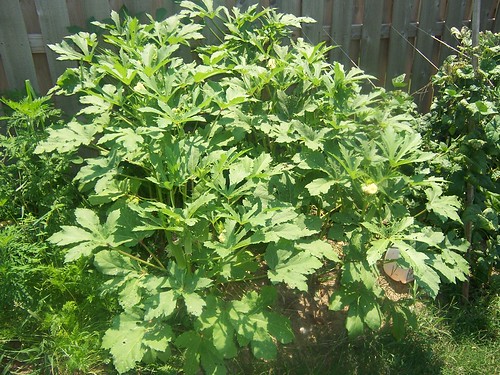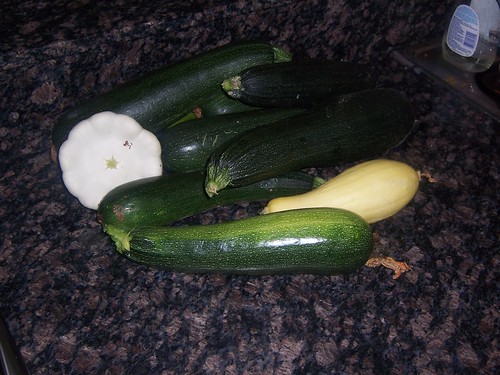Natural Selection and Tomatoes
I no longer believe all of the gardening advice about coddling tomato plants. Here's why:
Last year, I believed it. I carefully planted a bunch of tomato seeds in little pots indoors, watered them, gave them reasonable amounts of sunlight, nurtured them with love and care. When the little seedlings got a bit bigger, I followed the instructions about putting them outside only for a while, to get used to the sun, heat, wind, etc. Finally, after several weeks, I transplanted them outdoors. I had about 30 plants, some of which I put against our house, and some of which went against the backyard fence.
Well, 30 tomato plants turned out to produce way more tomatoes than my family could even conceivably eat, even if we ate tomatoes at every meal. So this year, I decided just to have about six plants against the fence. As for the space near the house, I planted several bushes.
Then I decided not to spend my time nurturing a bunch of tomato seeds with love and care. Instead, I bought six foot-tall plants from Lowe's, and planted them directly in the ground by the fence.
Lo and behold, after a while, the space near the house started sprouting up tomato plants. Apparently, a lot of tomatoes had dropped to the ground there last year, and the seeds then came up this spring. (Think of that: Seeds actually sprouting in the ground, surrounded by the rotting fruit that carried them, without human intervention! Who ever heard of such a thing?)
The plants that came up on their own are much healthier, lush, and profuse than any of the plants that I bought from Lowe's, some of which are pathetically spindly.
Here are the plants from Lowe's. Notice that none of them have even nearly reached the top of the stakes:

And here are the plants that came up by themselves, some of which (towards the back) have totally swamped the same wooden stakes:

I'd also point out that this picture doesn't give the full effect, because I already weeded out a bunch of tomato plants that were crowding out the bushes that I planted.
Why the difference? In one word: Natural selection.
The plants that I bought from Lowe's? Obviously, they had been coddled and sheltered indoors, just as the usual instructions would tell you. And as a result, the spindly and weak plants were able to survive to be sold at Lowe's. But as for the plants that came up by themselves -- well, the elements presumably already weeded out any of the sickly seedlings. The ones that survived were the strongest.
The lesson that I take from this is: Don't bother planting tomato seeds or plants in the spring. Instead, this fall or winter, go out and drop a bunch of fresh tomatoes on the ground. Then you may get some great plants that will come up on their own.
In other news, however, I'm pleased with the okra and squash:


Last year, I believed it. I carefully planted a bunch of tomato seeds in little pots indoors, watered them, gave them reasonable amounts of sunlight, nurtured them with love and care. When the little seedlings got a bit bigger, I followed the instructions about putting them outside only for a while, to get used to the sun, heat, wind, etc. Finally, after several weeks, I transplanted them outdoors. I had about 30 plants, some of which I put against our house, and some of which went against the backyard fence.
Well, 30 tomato plants turned out to produce way more tomatoes than my family could even conceivably eat, even if we ate tomatoes at every meal. So this year, I decided just to have about six plants against the fence. As for the space near the house, I planted several bushes.
Then I decided not to spend my time nurturing a bunch of tomato seeds with love and care. Instead, I bought six foot-tall plants from Lowe's, and planted them directly in the ground by the fence.
Lo and behold, after a while, the space near the house started sprouting up tomato plants. Apparently, a lot of tomatoes had dropped to the ground there last year, and the seeds then came up this spring. (Think of that: Seeds actually sprouting in the ground, surrounded by the rotting fruit that carried them, without human intervention! Who ever heard of such a thing?)
The plants that came up on their own are much healthier, lush, and profuse than any of the plants that I bought from Lowe's, some of which are pathetically spindly.
Here are the plants from Lowe's. Notice that none of them have even nearly reached the top of the stakes:

And here are the plants that came up by themselves, some of which (towards the back) have totally swamped the same wooden stakes:

I'd also point out that this picture doesn't give the full effect, because I already weeded out a bunch of tomato plants that were crowding out the bushes that I planted.
Why the difference? In one word: Natural selection.
The plants that I bought from Lowe's? Obviously, they had been coddled and sheltered indoors, just as the usual instructions would tell you. And as a result, the spindly and weak plants were able to survive to be sold at Lowe's. But as for the plants that came up by themselves -- well, the elements presumably already weeded out any of the sickly seedlings. The ones that survived were the strongest.
The lesson that I take from this is: Don't bother planting tomato seeds or plants in the spring. Instead, this fall or winter, go out and drop a bunch of fresh tomatoes on the ground. Then you may get some great plants that will come up on their own.
In other news, however, I'm pleased with the okra and squash:




0 Comments:
Post a Comment
Subscribe to Post Comments [Atom]
<< Home